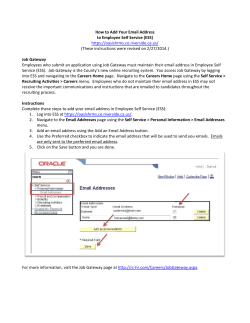
Cosylab FOR STUDENTS
IMPROVING THE MRF BASELINE rok.stefanic@cosylab.com Prague, June 5th 2014 Introduction Motivation for the presence Cosylab timing projects Cosylab wishes for MRF future 3 About Cosylab we are now 85 and part of big projects ITER, ESS, MedAustron, Solaris, FAIR…. we like to do things efficiently and standardize solutions which we believe is the most efficient for community my personal interest is timing-system standardization and besides above there are many emerging; RISP, MYRRHA, BNCT where timing system shall be crucial part we believe MRF is a very solid platform for timing system solutions 4 Timing projects ESS after analyzing ESS needs we believe MRF FW upgrades are needed we started with MRF “branch”, now we discussed with Timo to address this MedAustron highly customized, medical-suited FW upgrade of MRF extended MRF to provide virtual accelerator service 4PY put into real-time application layer for medical ramping-synchrotron accelerator together with Jukka made PXIe EVR RISP/RAON compare MRF “off the shelf” and WR we really appreciate MRF platform we can buy from Jukka FAIR it is WR, we are following this community and we understand situation Solaris MRF off the shelf + Tango MYRRHA MRF off the shelf + mrfioc2 MedAustron REDNET 1x MRF EVG REDNET = real-time event and data network requirement analysis, architecture design development (LV + FPGA), testing… effort: ~4 MY n-x MRF EVR ESS timing system implementation using standardized EPICS Nominal Device Support additions to MRF FW with fallback sequences, data emission coupled with sequences, “MPS” PoC effort: ~1.5 MY 7 RISP / RAON Requirements Compare MRF & WR Architecture 8 Cosylab wishes for MRF future data buffer emission done in RT (HW) and synchronized with sequencer(s) sequencer gating in different modes (direct termination, graceful termination) low level RT coupling with MPS automatic propagation delay compensation user trigger events with additional conditions for emission trigger timing event, delay, number of repetitions, decimation easier/standardized setup of the system - everyone needs to know the TS very well before "Hello World" can be made Abstraction layer – integrator should deal with his needs not direct HW configuration more complete SW support (additions to mrfioc2)
© Copyright 2025













